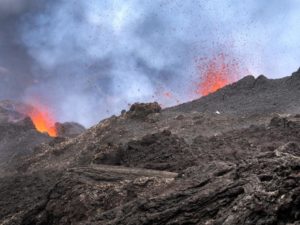UH Scientists Use Satellites to Predict End of Volcanic Eruptions
University of Hawai‘i at Mānoa (UHM) researchers have discovered a new method for predicting when lava flow-forming volcanoes will stop erupting using infrared satellite data.
UHM graduate student Estelle Bonny and her mentor, researcher Robert Wright of the Hawai‘i Institute for Geophysics and Planetology (HIGP), tested a hypothesis first published in 1981 using data gathered for nearly two decades by NASA satellites. The hypothesis predicts that once a lava flow-forming eruption starts, its rate of dispersion quickly peaks and then declines over a longer period of time until reaching zero.
HIGP faculty developed the methodology which detects and measures heat emissions from erupting volcanoes using satellite-based sensors. Through the data gathered in space, researchers are able determine lava flow rates and subsequently predict when volcano eruption rates will reach zero–essentially becoming extinct.
“The system has been monitoring every square kilometer of Earth’s surface up to four times per day, every day, since 2000,” said Bonny. “During that time, we have detected eruptions at more than 100 different volcanoes around the globe. The database for this project contains 104 lava flow-forming eruptions from 34 volcanoes with which we could test this hypothesis.”
Though the hypothesis has existed for decades, this is the first time satellite data has been used to find and measure lava flow rates. The results of the research will benefit people living near active volcanoes.
“Being able to predict the end of a lava flow-forming eruption is really important, because it will greatly reduce the disturbance caused to those affected by the eruption, for example, those who live close to the volcano and have been evacuated,” said Bonny.
“This study is potentially relevant for the Hawai’i island and its active volcanoes,” said Wright. “A future eruption of Mauna Loa may be expected to display the kind of pattern of lava discharge rate that would allow us to use this method to try to predict the end of eruption from space.”
Researchers plan to use the new approach during future eruptions as a predictive tool that can measure ongoing flows in near-real time.

















